• Figure 1 shows standing PA (Fig. 1A) and lateral scoliosis (Fig. 1B) radiographs of a 15-year-old patient with Lenke 1A adolescent idiopathic scoliosis. • The instrumentation end vertebrae can also be planned using these radiographs. • An axillary roll is placed under the left axilla and both shoulders and elbows are flexed 90°. • A pillow is placed between the elbows and one large “jelly” roll is placed behind the patient’s shoulders and another in front to help hold the position. • Four-inch cloth or silk tape is placed over the right shoulder to maintain the lateral position. • The C-arm is brought in and placed into the lateral position (PA of the thorax). A line is drawn down the center of the spine over the levels to be fused. The C-arm is rotated to the anteroposterior (AP) position and the center of each vertebral body is marked with a straight line parallel to the end plate from the posterior to the anterior thorax. The intersection of these lines and the line along the posterior axillary line is the location of the posterior portals, which will be primarily used for screw placement (Fig. 6A).
Thoracoscopic Release and Instrumentation for Scoliosis
Examination/Imaging
 A complete neurologic examination of the trunk and lower extremities, including abdominal reflexes, needs to be performed.
A complete neurologic examination of the trunk and lower extremities, including abdominal reflexes, needs to be performed.
 Assessment of rotational deformity is done using Adam’s forward bend test, trunk shift, and pelvic and shoulder symmetry. Examination from the side must not be overlooked as well in order to assess sagittal contour.
Assessment of rotational deformity is done using Adam’s forward bend test, trunk shift, and pelvic and shoulder symmetry. Examination from the side must not be overlooked as well in order to assess sagittal contour.
 Standing posteroanterior (PA) and lateral scoliosis films should be obtained, with careful consideration of the Lenke curve type, coronal and sagittal balance, pelvic obliquity, and shoulder height.
Standing posteroanterior (PA) and lateral scoliosis films should be obtained, with careful consideration of the Lenke curve type, coronal and sagittal balance, pelvic obliquity, and shoulder height.
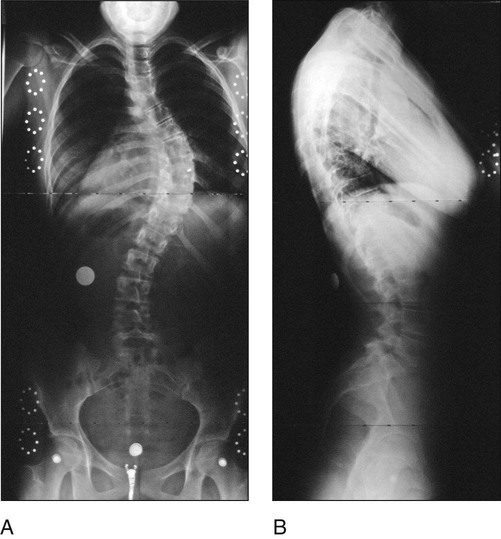
 Left and right bending films are obtained to determine the flexibility of the compensatory upper thoracic and lumbar curves as well as the flexibility of the main thoracic curve. Figure 2 shows left (Fig. 2A) and right (Fig. 2B) bending films of the same patient as in Figure 1.
Left and right bending films are obtained to determine the flexibility of the compensatory upper thoracic and lumbar curves as well as the flexibility of the main thoracic curve. Figure 2 shows left (Fig. 2A) and right (Fig. 2B) bending films of the same patient as in Figure 1.
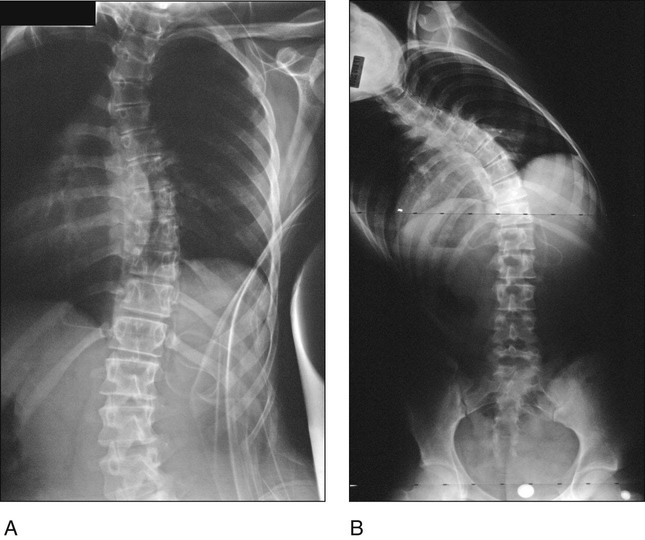
Surgical Anatomy
 Figure 3 is an anatomic sketch of the right hemithorax demonstrating the major structures.
Figure 3 is an anatomic sketch of the right hemithorax demonstrating the major structures.

 The lung must be deflated prior to exposure and completely reinflated at the time of closure.
The lung must be deflated prior to exposure and completely reinflated at the time of closure.
 Segmental vessels are at risk at two locations: during portal creation and during exposure of the vertebral body. Care must be taken when creating the portal to stay on the cephalad edge of the inferior rib. When exposing the vertebral body, segmental vessels must be carefully cauterized or clipped prior to division. Otherwise, bleeding may be difficult to control, requiring conversion to thoracotomy.
Segmental vessels are at risk at two locations: during portal creation and during exposure of the vertebral body. Care must be taken when creating the portal to stay on the cephalad edge of the inferior rib. When exposing the vertebral body, segmental vessels must be carefully cauterized or clipped prior to division. Otherwise, bleeding may be difficult to control, requiring conversion to thoracotomy.
 The azygos vein is located anterior and slightly to the right of the vertebral bodies (Fig. 4). This large and friable vein is the most posterior longitudinal vessel in the right hemithorax. It receives intercostal vessels cepahalad to the T6 level (sometimes lower).
The azygos vein is located anterior and slightly to the right of the vertebral bodies (Fig. 4). This large and friable vein is the most posterior longitudinal vessel in the right hemithorax. It receives intercostal vessels cepahalad to the T6 level (sometimes lower).
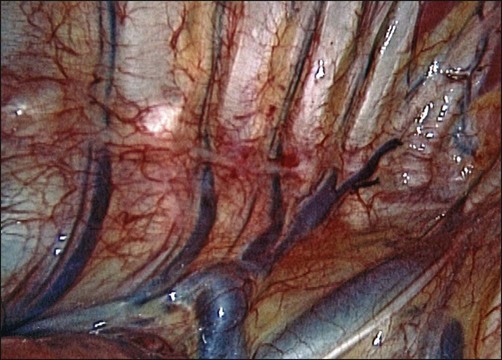
 The descending aorta is located on the left anterolateral spine from T4-8. The thoracic aorta crosses toward the midline at T9-12, and its location moves more anterior as the patient is moved from the supine to the prone position. The aortic arch is located cephalad to T4.
The descending aorta is located on the left anterolateral spine from T4-8. The thoracic aorta crosses toward the midline at T9-12, and its location moves more anterior as the patient is moved from the supine to the prone position. The aortic arch is located cephalad to T4.
 The thoracic duct is on the left side of the vertebrae cephalad to T4, and it crosses to the right to follow the aorta in the right hemithorax between the azygos vein and aorta. Transection may produce a persistant chylothorax.
The thoracic duct is on the left side of the vertebrae cephalad to T4, and it crosses to the right to follow the aorta in the right hemithorax between the azygos vein and aorta. Transection may produce a persistant chylothorax.
 The esophagus runs anterior to the vertebral column between the azygos vein and descending aorta.
The esophagus runs anterior to the vertebral column between the azygos vein and descending aorta.
 The sympathetic chain runs on both sides just anterior to the costovertebral joints.
The sympathetic chain runs on both sides just anterior to the costovertebral joints.
 The splanchnic nerve branches out to form a network of fine fibers between the azygos vein and sympathetic chain. Transection of some of these fibers is unavoidable.
The splanchnic nerve branches out to form a network of fine fibers between the azygos vein and sympathetic chain. Transection of some of these fibers is unavoidable.
 The ribs of the thoracic spine articulate with the transverse process and bridge the disk space. The rib bridges the disk space at the same-number vertebra and the one cephalad (e.g., the fifth rib head lies at the T4-5 disk space).
The ribs of the thoracic spine articulate with the transverse process and bridge the disk space. The rib bridges the disk space at the same-number vertebra and the one cephalad (e.g., the fifth rib head lies at the T4-5 disk space).
Positioning
 The lateral decubitus position is described here because it facilitates retraction of the lung and great vessels and is the preferred position of the authors.
The lateral decubitus position is described here because it facilitates retraction of the lung and great vessels and is the preferred position of the authors.
 The operating room table is placed in the center of the room parallel to its long axis. Monitors and other equipment are positioned as shown in Figure 5.
The operating room table is placed in the center of the room parallel to its long axis. Monitors and other equipment are positioned as shown in Figure 5.
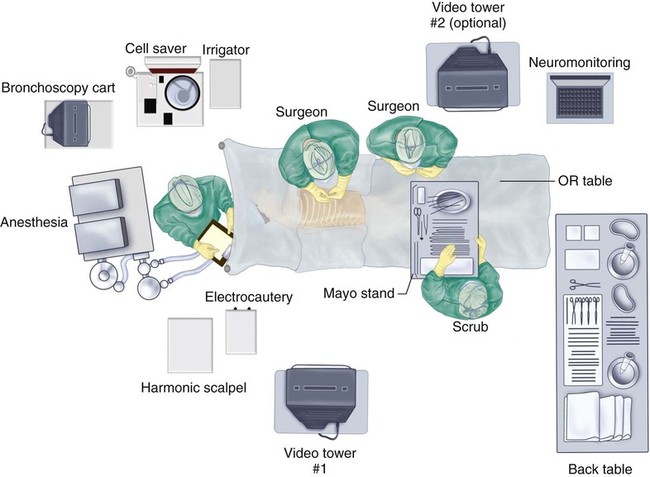
 Double-lumen endotracheal tube placement is performed in the supine position.
Double-lumen endotracheal tube placement is performed in the supine position.
 For most situations, the patient is placed on the left side.
For most situations, the patient is placed on the left side.
 The hips and knees are slightly flexed in an offset position and two to three pillows are placed between the knees. Another strip of tape is placed over the hips and a safety strap over the legs.
The hips and knees are slightly flexed in an offset position and two to three pillows are placed between the knees. Another strip of tape is placed over the hips and a safety strap over the legs.
Portals/Exposures
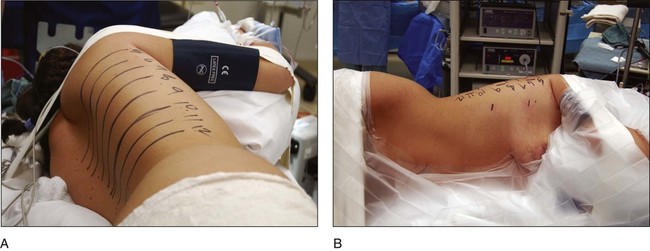
![]()
Stay updated, free articles. Join our Telegram channel

Full access? Get Clinical Tree


60: Thoracoscopic Release and Instrumentation for Scoliosis















